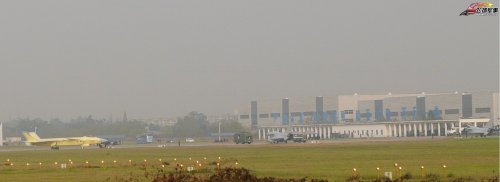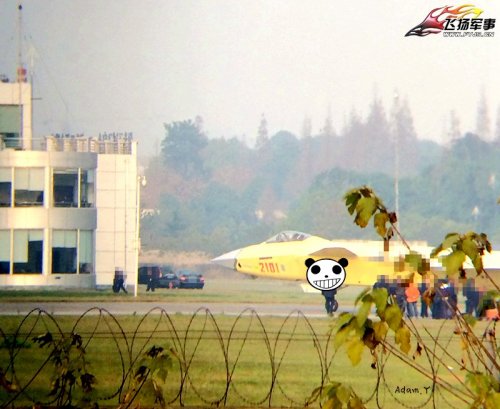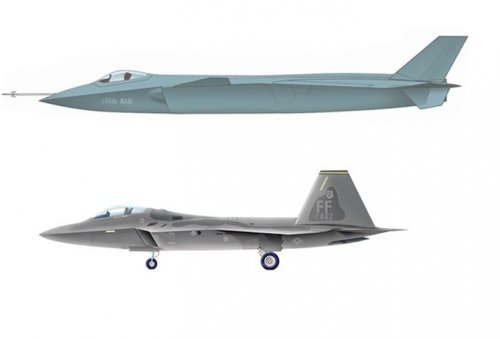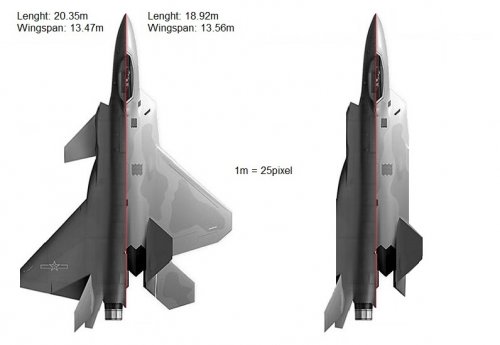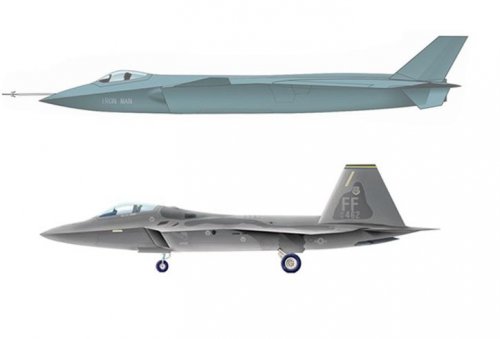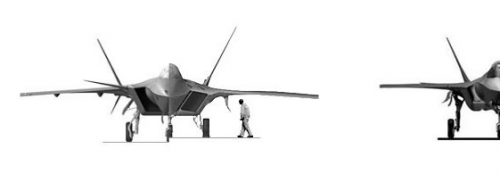You are using an out of date browser. It may not display this or other websites correctly.
You should upgrade or use an alternative browser.
You should upgrade or use an alternative browser.
Chengdu J-20 pictures, analysis and speculation Part II
- Thread starter overscan (PaulMM)
- Start date
- Joined
- 2 January 2006
- Messages
- 3,524
- Reaction score
- 3,121
- Joined
- 22 April 2012
- Messages
- 2,318
- Reaction score
- 1,841
Same panels are present on the J-20 prototypes, they are just harder to see as they are painted the same colour as the rest of the fuselage. I am happy to admit to not having a clue what they are.
FighterJock
ACCESS: Top Secret
- Joined
- 29 October 2007
- Messages
- 4,226
- Reaction score
- 3,417
JFC Fuller said:Same panels are present on the J-20 prototypes, they are just harder to see as they are painted the same colour as the rest of the fuselage. I am happy to admit to not having a clue what they are.
I was thinking about the Russian T-50 side looking radar, perhaps the J-20 has similar system.
sferrin said:Side arrays maybe?
Are you speaking of the two hexagonal shaped dark things on the side of the air intake?
Previous pictures have shown them to appear to be inlets of some kind.
There are some possible locations for side arrays, for instance on the side of the nose there is a thinnish, long diamond grey band which has been speculated to be indicative of a possible side looking radar.
FighterJock
ACCESS: Top Secret
- Joined
- 29 October 2007
- Messages
- 4,226
- Reaction score
- 3,417
flanker said:Just bleeds, ala those on the sides of T-50 intake. Certainly not radar installations.
Shame that they are only bleeds, so it looks like the T-50 is the only Fifth Generation fighter with side ways looking radar.
latenlazy
I really should change my personal text
- Joined
- 4 July 2011
- Messages
- 245
- Reaction score
- 37
FighterJock said:flanker said:Just bleeds, ala those on the sides of T-50 intake. Certainly not radar installations.
Shame that they are only bleeds, so it looks like the T-50 is the only Fifth Generation fighter with side ways looking radar.
There are some features on the side of the nose, but they may be too small for side looking radars.
- Joined
- 17 October 2006
- Messages
- 2,282
- Reaction score
- 607
It probably doesn't need them for its intended mission.
LowObservable said:It probably doesn't need them for its intended mission.
Speaking of which, has the J-20's intended role/mission ever been clearly stated/ascertained?
- Joined
- 17 October 2006
- Messages
- 2,282
- Reaction score
- 607
It has been accurately analyzed and reported.
- Joined
- 3 June 2011
- Messages
- 17,339
- Reaction score
- 9,076
LowObservable said:It has been accurately analyzed and reported.
By the PLA and Chinese press? I'd have thought that would have made it to this page by now. I think he's looking for something authoritative.
Exactly
- Joined
- 2 January 2006
- Messages
- 3,524
- Reaction score
- 3,121
sferrin said:I think he's looking for something authoritative.
I think You won't get any official explanation via the PLAAF, the MoD or CAC ... at least not soon. As such all we could do is to rely on the information available - like Mr. Song's paper - and decent analysis not made by these typical "eyeballing hobby-analysts which often enough state it is "big ... so big ! ... it must be a striker" !
The best and most balanced analyses is IMO this one (and quite funny it includes my own size estimation):
http://plarealtalk.com/2015/12/27/commentary-j-20-striker-interceptor/
Deino
- Joined
- 17 October 2006
- Messages
- 2,282
- Reaction score
- 607
A reasonable paper, aside from overlooking the great difference in body volume and dry supersonic thrust between the F-22 and J-20.
latenlazy
I really should change my personal text
- Joined
- 4 July 2011
- Messages
- 245
- Reaction score
- 37
And you know there's a great difference in body volume because?LowObservable said:A reasonable paper, aside from overlooking the great difference in body volume and dry supersonic thrust between the F-22 and J-20.
Regarding the weapons bay depth, it's almost impossible to derive a sensible comparison from the images provided in that paper (although it is admittedly hard to find imagery for both aircraft from angles that are both relevant and comparable).
The following photos would seem to indicate that the J-20 bay is significantly deeper than required for the AAM dummies (even allowing for the fins), unlike the F-22 bay is relative to the AIM-120. Also, the PL-12 (which you might reasonably assume drove length) is a bit longer than the AMRAAM - longer in fact than almost all internal F-35A/C payloads excluding the JSM (very close though) and JSOW. That expressly includes 2000 lb JDAMs and the Turkish SOM cruise missile!
http://military.tomsk.ru/forum/download/file.php?id=26929&mode=view
https://sinodefence.files.wordpress.com/2014/03/j-20-weapon-bay.jpg
F-22 for reference:
http://www.ausairpower.net/USAF/F-22A-JDAM-Bay-2S.jpg
The following photos would seem to indicate that the J-20 bay is significantly deeper than required for the AAM dummies (even allowing for the fins), unlike the F-22 bay is relative to the AIM-120. Also, the PL-12 (which you might reasonably assume drove length) is a bit longer than the AMRAAM - longer in fact than almost all internal F-35A/C payloads excluding the JSM (very close though) and JSOW. That expressly includes 2000 lb JDAMs and the Turkish SOM cruise missile!
http://military.tomsk.ru/forum/download/file.php?id=26929&mode=view
https://sinodefence.files.wordpress.com/2014/03/j-20-weapon-bay.jpg
F-22 for reference:
http://www.ausairpower.net/USAF/F-22A-JDAM-Bay-2S.jpg
- Joined
- 17 October 2006
- Messages
- 2,282
- Reaction score
- 607
L&L - Well, you see, the internal volume is often affected by the exterior dimensions. Funny, that. And when you compare the F-22 and J-20 body sizes and disregard the effin big H-tails flapping in the breeze behind the F-22, the difference is marked.
latenlazy
I really should change my personal text
- Joined
- 4 July 2011
- Messages
- 245
- Reaction score
- 37
LowObservable said:L&L - Well, you see, the internal volume is often affected by the exterior dimensions. Funny, that. And when you compare the F-22 and J-20 body sizes and disregard the effin big H-tails flapping in the breeze behind the F-22, the difference is marked.
Funny that indeed ;D. I remember doing this little exercise a while back. Since the J-20 seems to have a similar wingspan to the F-22 with similar fuselage cross section, the only significant difference in fuselage volume is length. Assuming the J-20 is about 20.3-20.5 meters, that would make it about 8% longer than the F-22, and since fuselage length seems to be the only dimension larger than the F-22 the J-20 should have about 8% more volume. That doesn't fit "great difference" for me (but maybe it does for you). You add in the fact that it has thinner wings and *much* smaller control surfaces (it's not just the F-22's honking huge vertical tails, but the difference between horizontal stabs vs canards), and I'm really not sure the J-20 is *that* much more voluminous. (Consequently it's why I also don't buy the J-20 will have significantly longer legs than the F-22 either).
- Joined
- 27 December 2005
- Messages
- 16,464
- Reaction score
- 19,179
LowObservable said:A reasonable paper, aside from overlooking the great difference in body volume and dry supersonic thrust between the F-22 and J-20.
Dry supersonic thrust is an attribute of an engine, not an airframe. There is ample evidence that J-20 will get a higher-thrust engine eventually.
The configuration selected is intended for supersonic performance *and* agility.
The weapons bays are designed around air/air ordnance. It is being tested with air/air weapons. Even if the thrust/weight ratio is lower than ideal on prototypes and pre-series aircraft, that mainly affects sustained turns and climbs, and can be fixed by a higher thrust engine later.
Its designed to counter the F-22 / PAK-FA.
- Joined
- 17 October 2006
- Messages
- 2,282
- Reaction score
- 607
Assuming the J-20 is about 20.3-20.5 meters, that would make it about 8% longer than the F-22
If you consider the F-22's overall length, yes. But that's not the right comparison.
If you consider the F-22's overall length, yes. But that's not the right comparison.
- Joined
- 27 December 2005
- Messages
- 16,464
- Reaction score
- 19,179
LowObservable said:Assuming the J-20 is about 20.3-20.5 meters, that would make it about 8% longer than the F-22
If you consider the F-22's overall length, yes. But that's not the right comparison.
Yes, the F-22's body ends quite a bit further from the overall end of the plane. In fact it's really quite hard to see where the F-22 puts its internal fuel.
latenlazy
I really should change my personal text
- Joined
- 4 July 2011
- Messages
- 245
- Reaction score
- 37
Which is where we get into weight/volume contribution from different sized control surfaces. If we're implying something about weight here, then it bears mention that we're assuming composition and internal structure are similar enough for density to be the same. If we're wrong about fuselage cross section by even 1 square meter average along the length of the plane that alone could throw off that 8% comparison by another 10-15%* up or under. If the J-20's wings are on average half as thin as the F-22's that would be another huge discrepancy in volume that the eye might miss. There are many ways that eye tests can be wrong here, hence my general ambivalence at your certainty.LowObservable said:Assuming the J-20 is about 20.3-20.5 meters, that would make it about 8% longer than the F-22
If you consider the F-22's overall length, yes. But that's not the right comparison.
LowObservable said:A reasonable paper, aside from overlooking the great difference in body volume and dry supersonic thrust between the F-22 and J-20.
I addressed the difference in overall length mostly to state that J-20 was not 23 meters long as was initially circulated (and still sometimes circulated) by various outlets. I could have written J-20 had greater body volume than F-22, and sought to make a possible conclusion from it, but the main goal was to definitively show J-20 was not as big as some still assume.
And I also did address the difference in thrust -- i.e.: that much of J-20's aerodynamic performance will be dependent on the actual engine J-20 has access to.
Note, I also deliberately and clearly said at the end of it: This entry does not make any claims about J-20’s aerodynamic performance relative to other specific aircraft beyond the suggestion that it is likely intended to compete with other air superiority aircraft in the air combat manoeuvring domain. -- and based on the premises and arguments I delivered I think that is a reasonable conclusion.
Trident said:Regarding the weapons bay depth, it's almost impossible to derive a sensible comparison from the images provided in that paper (although it is admittedly hard to find imagery for both aircraft from angles that are both relevant and comparable).
The following photos would seem to indicate that the J-20 bay is significantly deeper than required for the AAM dummies (even allowing for the fins), unlike the F-22 bay is relative to the AIM-120. Also, the PL-12 (which you might reasonably assume drove length) is a bit longer than the AMRAAM - longer in fact than almost all internal F-35A/C payloads excluding the JSM (very close though) and JSOW. That expressly includes 2000 lb JDAMs and the Turkish SOM cruise missile!
http://military.tomsk.ru/forum/download/file.php?id=26929&mode=view
https://sinodefence.files.wordpress.com/2014/03/j-20-weapon-bay.jpg
F-22 for reference:
http://www.ausairpower.net/USAF/F-22A-JDAM-Bay-2S.jpg
The purpose of that section of the paper was not to say that J-20 was incapable of potentially carrying relatively small diameter powered weapons, but rather that based on the current pictures we have (including the additional ones you have helpfully posted), it is highly doubtful that it has a suitable weapons bay for which strike is one of its primary missions. It could obviously carry some SDB weapons and possibly even a reduced diameter JSM type weapon, as a secondary strike role.
"Of course, one may envision the Chinese Air Force seeking to procure a small diameter, powered weapon able to fit within J-20’s weapons bay, such as a reduced diameter JSM-esque weapon or a SPEAR III equivalent; or the folding wing Kh-58UshKE missile which some western media claim China has purchased from Russia (but for which there is no indication of in the Chinese military watching community). However such missiles would only make the best of a poor strike aircraft design, as they would be limited to small warheads and relatively short range compared to full sized powered weapons, and far inferior to missiles such as the new YJ-12 (Lin & Singer, 2014). Therefore if J-20 were to field even a token naval strike role, it would require development of a new generation of small sized powered missiles, of which J-20 can only carry a small number, whose efficacy against a well defended United States carrier battlegroup would very doubtful at best."
I also wasn't saying that J-20's weapons bay was the exact same dimensions as F-22 -- it may well be a little bigger and a little deeper, but I think it is also a sensible argument to say that based off the pictures and information we currently have it is far from capable of carrying the kinds of strike weapons that would be needed for anti carrier missions... The comparison with F-22 was mostly to say that among the 5th generation fighters which have flown, J-20's weapons bay configuration most closely resembles that of the F-22 (especially relative to inlet ducts) in comparison to say F-35 or YF-23 or PAK FA.
FighterJock
ACCESS: Top Secret
- Joined
- 29 October 2007
- Messages
- 4,226
- Reaction score
- 3,417
Blitzo said:LowObservable said:A reasonable paper, aside from overlooking the great difference in body volume and dry supersonic thrust between the F-22 and J-20.
I addressed the difference in overall length mostly to state that J-20 was not 23 meters long as was initially circulated (and still sometimes circulated) by various outlets. I could have written J-20 had greater body volume than F-22, and sought to make a possible conclusion from it, but the main goal was to definitively show J-20 was not as big as some still assume.
And I also did address the difference in thrust -- i.e.: that much of J-20's aerodynamic performance will be dependent on the actual engine J-20 has access to.
Note, I also deliberately and clearly said at the end of it: This entry does not make any claims about J-20’s aerodynamic performance relative to other specific aircraft beyond the suggestion that it is likely intended to compete with other air superiority aircraft in the air combat manoeuvring domain. -- and based on the premises and arguments I delivered I think that is a reasonable conclusion.
Trident said:Regarding the weapons bay depth, it's almost impossible to derive a sensible comparison from the images provided in that paper (although it is admittedly hard to find imagery for both aircraft from angles that are both relevant and comparable).
The following photos would seem to indicate that the J-20 bay is significantly deeper than required for the AAM dummies (even allowing for the fins), unlike the F-22 bay is relative to the AIM-120. Also, the PL-12 (which you might reasonably assume drove length) is a bit longer than the AMRAAM - longer in fact than almost all internal F-35A/C payloads excluding the JSM (very close though) and JSOW. That expressly includes 2000 lb JDAMs and the Turkish SOM cruise missile!
http://military.tomsk.ru/forum/download/file.php?id=26929&mode=view
https://sinodefence.files.wordpress.com/2014/03/j-20-weapon-bay.jpg
F-22 for reference:
http://www.ausairpower.net/USAF/F-22A-JDAM-Bay-2S.jpg
The purpose of that section of the paper was not to say that J-20 was incapable of potentially carrying relatively small diameter powered weapons, but rather that based on the current pictures we have (including the additional ones you have helpfully posted), it is highly doubtful that it has a suitable weapons bay for which strike is one of its primary missions. It could obviously carry some SDB weapons and possibly even a reduced diameter JSM type weapon, as a secondary strike role.
"Of course, one may envision the Chinese Air Force seeking to procure a small diameter, powered weapon able to fit within J-20’s weapons bay, such as a reduced diameter JSM-esque weapon or a SPEAR III equivalent; or the folding wing Kh-58UshKE missile which some western media claim China has purchased from Russia (but for which there is no indication of in the Chinese military watching community). However such missiles would only make the best of a poor strike aircraft design, as they would be limited to small warheads and relatively short range compared to full sized powered weapons, and far inferior to missiles such as the new YJ-12 (Lin & Singer, 2014). Therefore if J-20 were to field even a token naval strike role, it would require development of a new generation of small sized powered missiles, of which J-20 can only carry a small number, whose efficacy against a well defended United States carrier battlegroup would very doubtful at best."
I also wasn't saying that J-20's weapons bay was the exact same dimensions as F-22 -- it may well be a little bigger and a little deeper, but I think it is also a sensible argument to say that based off the pictures and information we currently have it is far from capable of carrying the kinds of strike weapons that would be needed for anti carrier missions... The comparison with F-22 was mostly to say that among the 5th generation fighters which have flown, J-20's weapons bay configuration most closely resembles that of the F-22 (especially relative to inlet ducts) in comparison to say F-35 or YF-23 or PAK FA.
Anyone know the exact size of the new long-range PL-21 missile? That is supposed to fit inside the J-20 weapons bay.
latenlazy
I really should change my personal text
- Joined
- 4 July 2011
- Messages
- 245
- Reaction score
- 37
FighterJock said:Blitzo said:LowObservable said:A reasonable paper, aside from overlooking the great difference in body volume and dry supersonic thrust between the F-22 and J-20.
I addressed the difference in overall length mostly to state that J-20 was not 23 meters long as was initially circulated (and still sometimes circulated) by various outlets. I could have written J-20 had greater body volume than F-22, and sought to make a possible conclusion from it, but the main goal was to definitively show J-20 was not as big as some still assume.
And I also did address the difference in thrust -- i.e.: that much of J-20's aerodynamic performance will be dependent on the actual engine J-20 has access to.
Note, I also deliberately and clearly said at the end of it: This entry does not make any claims about J-20’s aerodynamic performance relative to other specific aircraft beyond the suggestion that it is likely intended to compete with other air superiority aircraft in the air combat manoeuvring domain. -- and based on the premises and arguments I delivered I think that is a reasonable conclusion.
Trident said:Regarding the weapons bay depth, it's almost impossible to derive a sensible comparison from the images provided in that paper (although it is admittedly hard to find imagery for both aircraft from angles that are both relevant and comparable).
The following photos would seem to indicate that the J-20 bay is significantly deeper than required for the AAM dummies (even allowing for the fins), unlike the F-22 bay is relative to the AIM-120. Also, the PL-12 (which you might reasonably assume drove length) is a bit longer than the AMRAAM - longer in fact than almost all internal F-35A/C payloads excluding the JSM (very close though) and JSOW. That expressly includes 2000 lb JDAMs and the Turkish SOM cruise missile!
http://military.tomsk.ru/forum/download/file.php?id=26929&mode=view
https://sinodefence.files.wordpress.com/2014/03/j-20-weapon-bay.jpg
F-22 for reference:
http://www.ausairpower.net/USAF/F-22A-JDAM-Bay-2S.jpg
The purpose of that section of the paper was not to say that J-20 was incapable of potentially carrying relatively small diameter powered weapons, but rather that based on the current pictures we have (including the additional ones you have helpfully posted), it is highly doubtful that it has a suitable weapons bay for which strike is one of its primary missions. It could obviously carry some SDB weapons and possibly even a reduced diameter JSM type weapon, as a secondary strike role.
"Of course, one may envision the Chinese Air Force seeking to procure a small diameter, powered weapon able to fit within J-20’s weapons bay, such as a reduced diameter JSM-esque weapon or a SPEAR III equivalent; or the folding wing Kh-58UshKE missile which some western media claim China has purchased from Russia (but for which there is no indication of in the Chinese military watching community). However such missiles would only make the best of a poor strike aircraft design, as they would be limited to small warheads and relatively short range compared to full sized powered weapons, and far inferior to missiles such as the new YJ-12 (Lin & Singer, 2014). Therefore if J-20 were to field even a token naval strike role, it would require development of a new generation of small sized powered missiles, of which J-20 can only carry a small number, whose efficacy against a well defended United States carrier battlegroup would very doubtful at best."
I also wasn't saying that J-20's weapons bay was the exact same dimensions as F-22 -- it may well be a little bigger and a little deeper, but I think it is also a sensible argument to say that based off the pictures and information we currently have it is far from capable of carrying the kinds of strike weapons that would be needed for anti carrier missions... The comparison with F-22 was mostly to say that among the 5th generation fighters which have flown, J-20's weapons bay configuration most closely resembles that of the F-22 (especially relative to inlet ducts) in comparison to say F-35 or YF-23 or PAK FA.
Anyone know the exact size of the new long-range PL-21 missile? That is supposed to fit inside the J-20 weapons bay.
We know literally nothing about the PL-21. It may not even exist if everything we've heard about it was actually the PL-15. Time will tell, I suppose.
Once a missile for a particular mission has reached sufficiently wide proliferation, it is common to design the replacement to fit approximately the same bounding box. That ensures existing handling and carriage interfaces do not have to be replaced as well, makes backwards compatibility for existing launch platforms much easier and allows new aircraft designs to proceed before the weapon itself is fully ready.
A particularly good example is AIM-7 -> AIM-120 (the latter fits into conformal wells on a fighter that flew more than 30 years earlier - the F-4). The size of future Chinese MRAAMs is therefore likely to be very similar to the PL-12 overall.
A particularly good example is AIM-7 -> AIM-120 (the latter fits into conformal wells on a fighter that flew more than 30 years earlier - the F-4). The size of future Chinese MRAAMs is therefore likely to be very similar to the PL-12 overall.
- Joined
- 6 November 2010
- Messages
- 4,228
- Reaction score
- 3,170
I have 18.92m for F-22's length, 67 feet (~20.40m) for J-20's length.
-------------------------------------- 38 dashes to represent F-22's length
------------------------------------------ 41 dashes to represent J-20's length
Now that I've had a closer look - probably not.Deino said:This is surely not to scale !
-------------------------------------- 38 dashes to represent F-22's length
------------------------------------------ 41 dashes to represent J-20's length
- Joined
- 24 November 2008
- Messages
- 1,334
- Reaction score
- 1,686
Arjen said:I have 18.92m for F-22's length, 67 feet (~20.40m) for J-20's length.
Now that I've had a closer look - probably not.Deino said:This is surely not to scale !
-------------------------------------- 38 dashes to represent F-22's length
------------------------------------------ 41 dashes to represent J-20's length
;D
Attachments
- Joined
- 27 December 2005
- Messages
- 16,464
- Reaction score
- 19,179
A good comparison image I think showing that the J-20 is longer but not necessarily larger. This would fit with an greater emphasis on low supersonic drag, perhaps due to less than ideal engines.
PaulMM (Overscan) said:A good comparison image I think showing that the J-20 is longer but not necessarily larger. This would fit with an greater emphasis on low supersonic drag, perhaps due to less than ideal engines.
Yes, the difference is nowhere near as big as the 23m-crowd would have us believe, but then I'd consider their views as having been largely discredited at least 2 years ago anyway.
Nonetheless, I think the J-20 is somewhat larger, as fuselage cross section is hardly smaller (if at all) than the Raptor's, going by a comparison of front views using what looks like the same set of drawings as VTOLicious did (and scaled to the same wing spans he used). Horizontal distance from the tip of the nose to the upper outside corner of the intake is a bit longer for the F-22 (as you'd expect from the planform comparison), then again the J-20 fuselage sides slope at a steeper angle, and inlet aspect ratio is higher which argues slightly greater fuselage depth.
On that last point it must be noted that the J-20 drawing is somewhat out of date, as it depicts the configuration of the first two airframes whereas from the third one on the upper intake lip slopes down rather than being horizontal (a bit like the F-35 that I included on the right). Whether the inlet area (and hence fuselage depth) actually is correspondingly reduced or the entire fuselage geometry changed more extensively I can't tell.
Attachments
Blitzo said:Trident said:Regarding the weapons bay depth, it's almost impossible to derive a sensible comparison from the images provided in that paper (although it is admittedly hard to find imagery for both aircraft from angles that are both relevant and comparable).
The following photos would seem to indicate that the J-20 bay is significantly deeper than required for the AAM dummies (even allowing for the fins), unlike the F-22 bay is relative to the AIM-120. Also, the PL-12 (which you might reasonably assume drove length) is a bit longer than the AMRAAM - longer in fact than almost all internal F-35A/C payloads excluding the JSM (very close though) and JSOW. That expressly includes 2000 lb JDAMs and the Turkish SOM cruise missile!
http://military.tomsk.ru/forum/download/file.php?id=26929&mode=view
https://sinodefence.files.wordpress.com/2014/03/j-20-weapon-bay.jpg
F-22 for reference:
http://www.ausairpower.net/USAF/F-22A-JDAM-Bay-2S.jpg
The purpose of that section of the paper was not to say that J-20 was incapable of potentially carrying relatively small diameter powered weapons, but rather that based on the current pictures we have (including the additional ones you have helpfully posted), it is highly doubtful that it has a suitable weapons bay for which strike is one of its primary missions. It could obviously carry some SDB weapons and possibly even a reduced diameter JSM type weapon, as a secondary strike role.
"Of course, one may envision the Chinese Air Force seeking to procure a small diameter, powered weapon able to fit within J-20’s weapons bay, such as a reduced diameter JSM-esque weapon or a SPEAR III equivalent; or the folding wing Kh-58UshKE missile which some western media claim China has purchased from Russia (but for which there is no indication of in the Chinese military watching community). However such missiles would only make the best of a poor strike aircraft design, as they would be limited to small warheads and relatively short range compared to full sized powered weapons, and far inferior to missiles such as the new YJ-12 (Lin & Singer, 2014). Therefore if J-20 were to field even a token naval strike role, it would require development of a new generation of small sized powered missiles, of which J-20 can only carry a small number, whose efficacy against a well defended United States carrier battlegroup would very doubtful at best."
I also wasn't saying that J-20's weapons bay was the exact same dimensions as F-22 -- it may well be a little bigger and a little deeper, but I think it is also a sensible argument to say that based off the pictures and information we currently have it is far from capable of carrying the kinds of strike weapons that would be needed for anti carrier missions... The comparison with F-22 was mostly to say that among the 5th generation fighters which have flown, J-20's weapons bay configuration most closely resembles that of the F-22 (especially relative to inlet ducts) in comparison to say F-35 or YF-23 or PAK FA.
Don't worry, I don't argue with your conclusion that the J-20 is neither 23m long nor a 5th generation F-111 analogue - it is definitely a F-22 counterpart. Nonetheless, it appears to make greater allowance for A/G than the F-22 does, with bays that are substantially deeper than they need to be for the MRAAMs we have thus far seen (unlike the Raptor, where the 1000lb JDAM is not actually deeper than AIM-120C + ejector). So much so that, as mentioned, the J-20 might possibly be able to accommodate some 90% of the F-35's internal payloads - as 5th generation fighters go, would you argue that the Lightning II is a bad strike aircraft? This is further borne out by the EO sensor on the J-20, which is located and configured to enable a FOV including straight down and rear angles analogous to EOTS.
Saying the J-20 is more suitable for strike missions than the F-22 is not the same as saying it isn't as good a fighter, let alone claiming it is something like a stealthy Tu-22M3
Trident said:Don't worry, I don't argue with your conclusion that the J-20 is neither 23m long nor a 5th generation F-111 analogue - it is definitely a F-22 counterpart. Nonetheless, it appears to make greater allowance for A/G than the F-22 does, with bays that are substantially deeper than they need to be for the MRAAMs we have thus far seen (unlike the Raptor, where the 1000lb JDAM is not actually deeper than AIM-120C + ejector). So much so that, as mentioned, the J-20 might possibly be able to accommodate some 90% of the F-35's internal payloads - as 5th generation fighters go, would you argue that the Lightning II is a bad strike aircraft? This is further borne out by the EO sensor on the J-20, which is located and configured to enable a FOV including straight down and rear angles analogous to EOTS.
Well, I do agree that J-20 compared to F-22 may have a "greater allowance" for air to ground weapons than F-22 due to its potentially larger weapons bay, though how much larger its weapons bay actually is vs F-22 is another matter.
I also do not believe the chin mounted EOIRST on J-20 is necessarily indicative of an A2G role -- for instance, the YF-23 and F-22 both were intended to have an EOIRST potentially mounted on their chins, and both were of course intended to have primary A2A roles. Similarly, I believe the F-14's chin mounted AN/AAS-42 was primarily for A2A roles as well.
I think it also makes sense for a stealthy air to air fighter to have an EOIRST mounted on its chin, if there is insufficient space on the dorsal side of the nose (such as due to a slanted radome bulkhead and other sensors or machinery occupying the dorsal side making a stealthy EOIRST fairing impractical to fit) -- and given such a fighter would likely spend most of its time at high altitudes, having an EOIRST which has look down capabilities may be sensible. J-20's EOIRST would have an A2G role if it were confirmed to have a laser designator and laser spot tracking capability, which I think are key prerequisites for A2G strike duties for such a sensor fairing.
I also wouldn't say F-35 is a bad strike aircraft -- I think it is perfectly fine, given the requirements it was designed for. However I don't think the requirements of F-35 would necessarily be consistent with Chinese military aviation requirements.
Saying the J-20 is more suitable for strike missions than the F-22 is not the same as saying it isn't as good a fighter, let alone claiming it is something like a stealthy Tu-22M3In other words, I see F-22 -> J-20 as roughly comparable to Typhoon -> Rafale, certainly not F-22 -> F-35 or even Su-35S -> Su-34 (as the 23m-crowd would have us believe).
I'd agree with this -- though I would admit that it is possible F-22 may not be as maneuverable as F-22 in certain flight regimes or conditions to a degree. However the key point is that in terms of role and ACM it probably is meant to be competitive with other air superiority fighter aircraft.
Blitzo said:I also do not believe the chin mounted EOIRST on J-20 is necessarily indicative of an A2G role -- for instance, the YF-23 and F-22 both were intended to have an EOIRST potentially mounted on their chins, and both were of course intended to have primary A2A roles. Similarly, I believe the F-14's chin mounted AN/AAS-42 was primarily for A2A roles as well.
As mentioned, it's not just the location alone though - there have been plenty of pure fighters/interceptors with dedicated IRSTs mounted below the nose (early F-4s, Draken, MiG-23, MiG-31...), but not one of them has a sensor window allowing straight down and rear visibility as required for level bombing with laser guided bombs, like the J-20 appears to. I don't think the drag penalty for that would be accepted without good reason (compare to the intended integration of the F-22/-23 installations).
Blitzo said:I'd agree with this -- though I would admit that it is possible F-22 may not be as maneuverable as F-22 in certain flight regimes or conditions to a degree. However the key point is that in terms of role and ACM it probably is meant to be competitive with other air superiority fighter aircraft.
Just as with Typhoon and Rafale.
Similar threads
-
-
-
-
Shenyang FC-31 prototype to J-XY / J-35 naval fighter
- Started by Foxglove
- Replies: 714
-
Sukhoi Su-57 / T-50 / PAK FA - flight testing and development Part II [2012-current]
- Started by overscan (PaulMM)
- Replies: 3K



